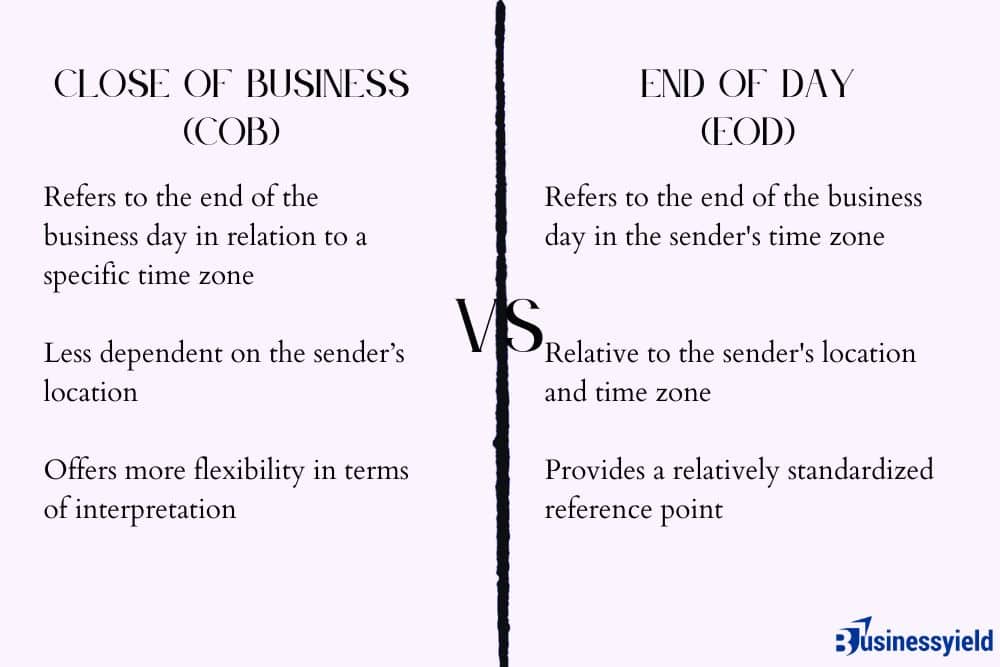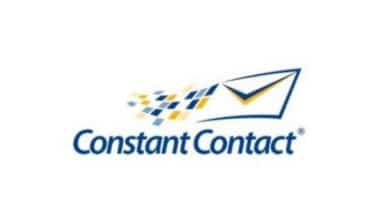Were you a tad confused the first time you came across the term COB in an email? Well, I know I certainly was. “I need your response by COB today”. What did it mean, I wondered?
That was my introduction to the world of business acronyms, and it didn’t take long for me to see their usefulness. They make lengthy emails easier to digest, lead to better communication skills, and, if you’re a nerd like me, make you feel a little like you’re communicating instructions for a covert mission.
However, these acronyms can also be confusing and frustrating, especially if you’re encountering them for the first time or you come across a new one that you don’t know the meaning.
Key takeaways
COB stands for “close of business.”
It refers to the end of a business day and the close of the financial markets in New York City, which define U.S. business hours.
It’s used in business communications to set a deadline for a task to be completed by 5:00 PM Eastern Standard Time (EST).
COB can be used interchangeably with end of business (EOB), end of day (EOD), end of play (EOP), close of play (COP), and close of business (COB).
What does COB mean?
COB stands for “close of business”. It is a term that professional organizations use when referring to the end of the business day.
Many professionals base COB hours on times that businesses traditionally close in the United States, which is typically 5 p.m. Eastern Standard Time (EST). Employers commonly refer to this time when establishing a deadline. For example, if a supervisor says to complete a task by COB on Friday, the assignment’s deadline would be 5 p.m. EST on Friday.
COB is also the time that the stock markets close in New York City, which is typically why many business professionals regularly use and understand this acronym. Some employers use COB interchangeably with similar acronyms, like the end of business (EOB), which typically has the same meaning.
COB is a convenient way to communicate deadlines and expectations within a business context. However, it’s essential to clarify the exact meaning of COB when setting deadlines, especially when dealing with individuals or parties in different time zones or regions, to avoid any misunderstandings.
What are business days?
Business days, also known as working days, are the weekdays when most businesses and organizations operate and conduct their regular activities. These days typically exclude weekends (Saturday and Sunday) and official holidays. Business days are essential for conducting various business-related operations, such as transactions, meetings, customer service, and administrative tasks.
A business day usually refers to the traditional operational hours of an organization, which are usually 9 a.m. to 5 p.m. Monday through Friday. When organizations mention business hours, they’re usually talking about these traditional times. Even if an organization is open in the evenings, most professionals rarely consider those to be business hours.
Normal or reasonable business hours can vary depending on the country, industry, and specific business practices. However, there are some general guidelines for what is considered normal or standard business hours in many English-speaking countries, including the United States, Canada, and the United Kingdom.
These hours typically fall within the range of:
- Monday through Friday: Business days generally span from Monday to Friday, with Saturday and Sunday typically considered weekends.
- 9:00 AM to 5:00 PM: The core of the business day typically falls within the hours of 9:00 AM and 5:00 PM. This 9-to-5 schedule is a common reference point for standard business hours.
- Lunch break: Many businesses have a designated lunch break, often around noon, which can last anywhere from 30 minutes to an hour. During this time, some offices and shops may temporarily close or have reduced staffing.
When should you use COB in an email?
Some common situations when you might use COB in an email include:
- Setting employee deadlines. When assigning tasks or projects to employees, you can use COB to communicate when you expect the work to be completed. For example, “Please have the project report on my desk by COB tomorrow.”
- Project management. COB is often used in project management to establish deadlines for specific project milestones or deliverables. For example, “The design phase must be completed by COB next Tuesday.”
- Client or customer requests. When requesting information, documents, or actions from clients or customers, you can use COB to provide a clear timeframe. For instance, “We need your approval on the contract changes by COB today.”
- Meeting scheduling. When proposing meeting times, you can suggest a time by COB to indicate that you’d like the meeting to be scheduled by the end of the business day. For instance, “Let’s work to schedule the client meeting by COB tomorrow.”
- Internal communications. COB can be used in internal emails or messages to convey internal deadlines or expectations within an organization. For example, “Please submit your expense reports for this month by COB on the 18th.”
- Vendor or supplier requests. When dealing with vendors or suppliers, you can use COB to specify when you need deliveries, shipments, or responses. For instance, “We require the materials to be delivered by COB next Friday.”
How to use COB in the workplace
Correctly using the acronym COB at work depends on who you’re speaking to and where they’re located. It’s important to remember what COB stands for since phrases like “COB of business” are redundant.
Here are a few examples of how to use COB correctly in the workplace.
Setting employee deadlines
COB is often used when setting deadlines for employees or potential hires. It’s particularly helpful when you need a certain task completed by a fixed time. If you’re sending a list of to-do items or repetitive tasks to multiple employees, using the acronym COB can help you save time and reduce the amount of typing you or your staff members need to do.
For example:
Hi James,
Upcoming tasks for you to complete this week are:
- Prepare financial reports by Tuesday COB
- Create a profit report presentation by Thursday COB
- Sort through and organize company financial records by Friday COB
Communicating with local contacts
For local contacts, use COB when describing a deadline for a project or important task in an email. Here’s an example:
Hello Mr. Michael,
I am writing to follow up after our marketing meeting. To proceed, we need some additional details from your team. Please provide the following:
- Budget estimation for upcoming projects
- Contact information for your human resources director
Please submit these details by COB on Tuesday, July 14.
Sincerely,
Elizabeth Turner
Communicating with out-of-state clients
When communicating with clients or suppliers who are out of the state or out of the country, you can still use COB to give deadlines. Make sure to specify the time, especially if it’s a new business relationship or your first time using the COB acronym with that individual or organization. Whether you’re communicating with a supplier in India or a client in London, include specifics for your location to avoid confusion.
For example:
Please submit this information to us by COB (5 pm EST).
Below is a checklist outlining how to use COB in an email in the workplace:
How to use COB in an email
Examples of COB in email
To help showcase the COB meaning in email, check out the following examples of how you can use this acronym to indicate a timeline:
Example 1:
Dear Philip,
We look forward to adding your marketing data to our upcoming report to the leadership team. Please send over your department’s marketing data by COB (5 p.m. EST) on Friday, September 2, to ensure inclusion in our report.
If you have any further questions, please let me know.
Sincerely,
Jimmy Arnis
Example 2:
Hi Emmanuel,
I’m looking forward to including your slides in our marketing presentation to the digital transformation team. I am touching base to remind you to please have your final presentation slides emailed to me by COB on Monday, September 5, 2022.
If you have any further questions, please don’t hesitate to reach out.
Sincerely,
Jimmy Arnis
Example 3:
Hi Stanley,
Thank you for completing the first step in applying for our marketing manager position. Please make sure that you have completed your application by COB (5 p.m. EST) on Friday, September 23, 2022, to be considered for this role.
If you have any further questions, please don’t hesitate to reach out.
Sincerely,
Jimmy Arnis
Tips for using COB in business
While COB can be a handy acronym for indicating a deadline or timeline for a project’s completion, it is important to use the abbreviation carefully. While you might understand COB meaning, that does not mean that everyone you correspond with does. For that reason, be sure to employ these tips when using COB in an email or letter:
- Don’t repeat your ending. The acronym COB stands for close of business. As such, it is incorrect to type out COB business. In this case, the repeat of business is redundant.
- Make sure to clarify. Along with the abbreviation COB, be sure to also include a timestamp and date. For example, rather than asking for a document to be submitted by COB, you should ask for a document to be submitted by COB (5 p.m. EST) on the Date, Month, and Year. This will help ensure that there is no miscommunication about a deadline.
- Help new employees. When you work in a professional business setting for several years, it can be easy to grow accustomed to using acronyms. However, as new employees are hired, particularly those with little professional experience, these acronyms can be confusing. Make sure to help new employees learn important business acronyms. You can even outline acronyms your organization commonly uses in onboarding documents or employee resource guides. This will help prevent confusion and ensure that all employees are on the same page when communicating.
- Don’t include the weekends. When referring to COB or EOD, avoid using these to indicate a deadline over the weekend. Traditionally, business days are only considered to be Monday through Friday. In some rare cases, you might indicate a weekend deadline due to a specialized project or when working with business associates who have weekend hours.
When writing business correspondence, clear communication is key. If you plan to use acronyms, such as COB or EOD, always pair these business terms with a concise explanation of deadline expectations.
COB vs EOD: How are they different?

Some employers may use EOD and COB interchangeably, but they have a few key differences. When supervisors assign tasks to complete by EOD, they usually expect employees to complete them by the end of the business day in their own time zone. If someone assigns a task to someone in a different time zone, then it’s usually due by the end of the business day in the sender’s time zone.
Below are the differences between COB & EOD:
- COB often refers to the end of the business day in relation to a specific time zone, typically Eastern Standard Time (EST) in the United States. EOD generally refers to the end of the business day in the sender’s time zone.
- COB is often associated with a specific time zone (e.g., EST) and is less dependent on the sender’s location. This can provide more clarity in cross-border or international communication. EOD’s meaning is relative to the sender’s location and time zone. If the sender is in a different time zone from the recipient, it can lead to potential misunderstandings.
- EOD can offer more flexibility in terms of interpretation, as it can be specific to the sender’s local time. However, this flexibility can also lead to misunderstandings in global contexts. While COB provides a relatively standardized reference point, making it a more suitable choice when communicating across different time zones or when precise timing is important.
Other common workplace acronyms
Businesses may use many other workplace acronyms in place of or alongside COB. Other common terms that have a similar meaning include:
- End of business day (EOD): This synonym for COB is used to represent the end of the workday for employees, excluding weekends.
- End of play (EOP): Commonly used in place of COB, EOP references the time that the stock market closes. It’s most common in the financial industry.
- Close of play (COP): This term has the same meaning as COB and EOP. It refers to the end of the business day or the time the financial markets close. It’s also used in sports.
COB in email: Conclusion
COB is a useful term to use in emails and other business communication to specify deadlines for tasks and requests. However, it is important to be clear and specific about what you are asking for and when you expect it to be completed, to specify the time zone in which you are located, and to be mindful of the schedules of the people you are communicating with.
By following these guidelines, you can ensure that your emails are clear, concise, and effective at getting things done.
Money Management: Top 10+ Easy Tips to Becoming a Pro
ESPN Logo: What’s the True Meaning of the Logo
Boosting Construction Employee Productivity: Effective Time Management Strategies
AMERICAN RESIDENTIAL WARRANTY: Best Easy Guide for Newbies(Opens in a new browser tab)






